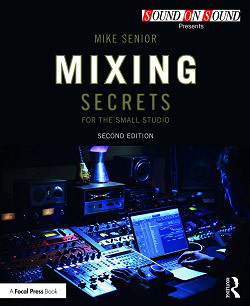Mixing Secrets For The Small Studio - Additional Resources
Chapter 14: Side-chains
Table of Contents
Workflow Demonstration Video
If you have trouble downloading or playing this video, here's a mirror file on an alternate server.
Audio Files
(To download all WAV examples at once: 44MB ZIP)
Side-chain Triggered Ducking: A common application of ducking can be heard in Mix Rescue September 2008 Ex14.01: WAV/MP3play_arrow, where the low frequencies of the kick-drum and bass-guitar parts are competing for space in the mix. Ducking the bass part makes the low end better controlled Ex14.02: WAV/MP3play_arrow. Ducking can also be used wherever there is an important part which wants to cut through other less important mix elements. In Mix Rescue May 2009, for example, I ducked a number of background parts in response to the kick drum, so that it would remain clear and audible throughout (without ducking Ex14.03: WAV/MP3play_arrow; with ducking Ex14.04: WAV/MP3play_arrow). Kick-triggerered ducking is also commonly used in dance styles to create mix-pumping effects, as in the following simple example from Mix Rescue February 2009: in this file the kick-drum and synth levels don’t interact Ex14.05: WAV/MP3play_arrow, while here the kick-drum is feeding a ducker’s side-chain to create level-pumping on the synths Ex14.06: WAV/MP3play_arrow.
Side-chain Triggered Gating: The thing I use side-chain triggered gating for most often is to rebalance drum recordings. For example, check out the drum overheads track from Mix Rescue May 2011 Ex14.16: WAV/MP3play_arrow, where the cymbals are overpowering the snare-drum sound – not an uncommon occurrence in home-studio recordings, where people have a habit of putting the overhead mics right on top of the cymbals! Using the snare close mic to key a gate on the overheads, you can significantly increase the snare level in the overheads balance Ex14.17: WAV/MP3play_arrow, which usually improves the overall snare tone. Another useful application of side-chain triggered gating is in matching the rhythmic feel of one track more closedly to that of another. Here, for example, is a rather bland sampled shaker part Ex14.07: WAV/MP3play_arrow which I added during Mix Rescue March 2009. In order to retain some of the rhythmic feel of the original shaker part Ex14.08: WAV/MP3play_arrow, I triggered a gate on the sample channels from the original shaker part, to give this much more musical feel Ex14.09: WAV/MP3play_arrow. Here’s a similar example from Mix Rescue February 2009, where pedestrian rhythm guitar parts Ex14.10: WAV/MP3play_arrow are given a little more rhythmic lilt by virtue of limited-range gating triggered from the kick drum Ex14.11: WAV/MP3play_arrow.
Some Advanced Examples: The following two Mix Rescue case studies explain the rationale behind some particularly involved side-chain-triggered processing. In Mix Rescue May 2009 I used the lead vocal level to trigger a compressor on the hi-hat parts in a move to combat subjective sibilance levels (before processing Ex14.12: WAV/MP3play_arrow; after processing Ex14.13: WAV/MP3play_arrow). In Mix Rescue May 2010 I demonstrated how an equalised and polarity-inverted parallel gate channel could be used to clear space for the lead vocal within a crowded arrangement (before processing Ex14.14: WAV/MP3play_arrow; after processing Ex14.15: WAV/MP3play_arrow). Note that the cancellation effect in this example is under the control of mixer automation, so it’s very mild to start with and only gets stronger as the backing track’s texture thickens.
Links
- Affordable Dynamics Plug-ins With Side-chain Access: There are a lot of plug-ins now that provide external side-chain inputs. Freeware options include Bob Perry Gate

 ; Cockos ReaGate
; Cockos ReaGate and ReaComp
and ReaComp ; Dead Duck Expander
; Dead Duck Expander & Gate
& Gate ; Melda MCompressor
; Melda MCompressor
 ; Sleepy Time DSP Transient
; Sleepy Time DSP Transient ; Xhip Gate
; Xhip Gate
 . For anything more involved, such as side-chain-triggered frequency-selective compression/expansion, try Toneboosters’s affordable Equalizer
. For anything more involved, such as side-chain-triggered frequency-selective compression/expansion, try Toneboosters’s affordable Equalizer
 , which is both incredibly powerful and fairly easy to use. (If your DAW doesn’t support plug-ins with external side-chains, then get try Cockos Reaper
, which is both incredibly powerful and fairly easy to use. (If your DAW doesn’t support plug-ins with external side-chains, then get try Cockos Reaper
 .) However, for advanced spectral ducking applications it’s also worth checking out SoundRadix SurferEQ
.) However, for advanced spectral ducking applications it’s also worth checking out SoundRadix SurferEQ
 and Waves Factory Trackspacer
and Waves Factory Trackspacer
 .
.
Further Reading
Side-chain Triggering In Practice: I use side-chain triggering all the time in Mix Rescue, but here are a few of the remixes where side-chain dynamics had a larger role to play: Mix Rescue July 2010, Mix Rescue May 2010, Mix Rescue May 2009, and Mix Rescue February 2009.
More Information On Gating: There are more specific triggered gating tricks detailed in this ‘Advanced Gating’ article.

